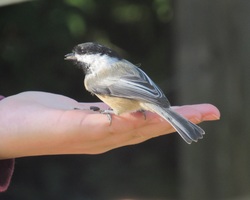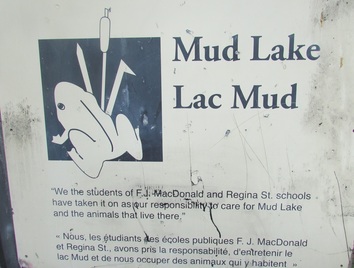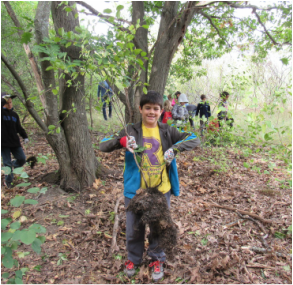
When I first approached our school librarian, Connie Bruce, with the idea of taking my class on a weekly nature walk to the nearby Mud Lake Conservation Area, the focus was on creating a shared experience for the students. We knew we could connect nature to many areas of the curriculum, but little did we know that we had stumbled upon an activity that would fundamentally change our teaching practice and enhance the well-being of all those involved.
The idea that regular exposure to nature has a positive effect on mental health makes sense to those of us who regularly spend time outdoors. Current research clearly shows that there is a strong link between time spent outside and well-being, as evidenced in a recent news article, “Your Happiness Could Depend on the Time You Spend Outdoors”, found on the Trent University website.
"Spending time in nature is good for your health and can make you happier," says Dr. Lisa Nisbet, assistant professor of Psychology at Trent University. Professor Nisbet studies how people's sense of connection to nature influences their physical and mental health as well as their sustainable behaviour.
"Our research shows that connection with nature is associated with greater well-being," Prof. Nisbet explains. “The more somebody feels a connection with the natural world, the more that person will report having a greater sense of happiness - more positive (and fewer negative) emotions, a greater sense of vitality, as well as more satisfaction with life."
At Regina Street Public School, we recognized, early in our journey, that taking learning outdoors had a powerful effect on how students felt about themselves. The simple act of feeding a chickadee on a winter day showed students that they could play a vital role in the life of another living thing. It reinforced the idea that nature didn’t care where the students lived, what language they spoke, or how affluent they were.
As we spent more time outside, it became apparent that we were watching, in action, what research suggested would happen. After 20 minutes outside, ADHD symptoms were reduced for students. In fact students with attention issues in the classroom were often the most proficient students when it came to observing even minor changes in the Mud Lake habitats or spotting hard-to-see animals.
A 2013 article in Psychology Today summarized current research related to the topic and and the author, Victoria M. Dunckley, M.D., concluded by saying, “Here we have a natural intervention that can help avoid use of psychotropic drugs, promote overall physical health, decrease the stress response, support brain integration and development, and improve psychosocial functioning. What’s not to love?”
But there are many more health benefits to regular exposure to nature. Recently, the Canadian Parks Council, in collaboration with federal, provincial, and territorial park systems published a document entitled “Connecting Canadians with Nature - An Investment in the Well-Being of Our Citizens”. Their findings, related to the benefits of connecting with nature, are best summed up by the following quote.
“Nature is good for us. We rely on nature for fresh air and clean water, and for what we eat. People gravitate to natural spaces to restore and rejuvenate, to heal, and to feel calm. Nature helps release our minds from the constraints of modern life. It awakens our senses. It draws us outward and reminds us that we are part of something bigger than ourselves. Our brains develop differently with natural experiences.”
Last spring, as daily preparation for completion of provincial standardized testing (EQAO), our grade 6 students and their teachers spent 30 minutes walking through Mud Lake before beginning the day’s testing sessions. They prepared their minds by quietly observing the natural world at their “sit spots”, following what had become a routine over the previous three years. Compared to other years, the students displayed less anxiety about the assessment and were able to maintain engagement throughout all daily segments of the test. In the end, student scores were well above the provincial average in reading and writing (13 out of 14 students at or above provincial standard in reading and all 14 students in writing), and slightly above in math.
In 2009, the Ontario government passed Bill 177 which required all school boards to promote student achievement and well-being. In response, our school board created the OCDSB Framework for Student Well-being to guide district schools in supporting and promoting the three dimensions of student well-being (physical, socio-emotional, and cognitive). Upon close examination of this document, it’s clear that the nature-based learning that we provide at Regina Street Public School follows all of the guiding principles set out in the framework.
We see examples every day of the ways that exposure to nature increases the confidence of student learners, but we also recognize that this confidence comes through intentionally-planned activities that allow each student to be successful in meeting curriculum objectives in a non-threatening manner. Critical thinking and creative problem-solving are the cornerstones of learning experiences that extend well beyond the classroom into the community, creating active and engaged citizens who feel they have a voice in their lives, now and in the future.
Over the past five years, we have worked hard, as a staff, to extend nature-based learning to all classrooms within our school, providing opportunities for all our students to experience an adventure in learning on a regular basis. It’s given our school community an identity to be proud of, and provided each student with safe and caring spot to grow academically and socially.
The idea that regular exposure to nature has a positive effect on mental health makes sense to those of us who regularly spend time outdoors. Current research clearly shows that there is a strong link between time spent outside and well-being, as evidenced in a recent news article, “Your Happiness Could Depend on the Time You Spend Outdoors”, found on the Trent University website.
"Spending time in nature is good for your health and can make you happier," says Dr. Lisa Nisbet, assistant professor of Psychology at Trent University. Professor Nisbet studies how people's sense of connection to nature influences their physical and mental health as well as their sustainable behaviour.
"Our research shows that connection with nature is associated with greater well-being," Prof. Nisbet explains. “The more somebody feels a connection with the natural world, the more that person will report having a greater sense of happiness - more positive (and fewer negative) emotions, a greater sense of vitality, as well as more satisfaction with life."
At Regina Street Public School, we recognized, early in our journey, that taking learning outdoors had a powerful effect on how students felt about themselves. The simple act of feeding a chickadee on a winter day showed students that they could play a vital role in the life of another living thing. It reinforced the idea that nature didn’t care where the students lived, what language they spoke, or how affluent they were.
As we spent more time outside, it became apparent that we were watching, in action, what research suggested would happen. After 20 minutes outside, ADHD symptoms were reduced for students. In fact students with attention issues in the classroom were often the most proficient students when it came to observing even minor changes in the Mud Lake habitats or spotting hard-to-see animals.
A 2013 article in Psychology Today summarized current research related to the topic and and the author, Victoria M. Dunckley, M.D., concluded by saying, “Here we have a natural intervention that can help avoid use of psychotropic drugs, promote overall physical health, decrease the stress response, support brain integration and development, and improve psychosocial functioning. What’s not to love?”
But there are many more health benefits to regular exposure to nature. Recently, the Canadian Parks Council, in collaboration with federal, provincial, and territorial park systems published a document entitled “Connecting Canadians with Nature - An Investment in the Well-Being of Our Citizens”. Their findings, related to the benefits of connecting with nature, are best summed up by the following quote.
“Nature is good for us. We rely on nature for fresh air and clean water, and for what we eat. People gravitate to natural spaces to restore and rejuvenate, to heal, and to feel calm. Nature helps release our minds from the constraints of modern life. It awakens our senses. It draws us outward and reminds us that we are part of something bigger than ourselves. Our brains develop differently with natural experiences.”
Last spring, as daily preparation for completion of provincial standardized testing (EQAO), our grade 6 students and their teachers spent 30 minutes walking through Mud Lake before beginning the day’s testing sessions. They prepared their minds by quietly observing the natural world at their “sit spots”, following what had become a routine over the previous three years. Compared to other years, the students displayed less anxiety about the assessment and were able to maintain engagement throughout all daily segments of the test. In the end, student scores were well above the provincial average in reading and writing (13 out of 14 students at or above provincial standard in reading and all 14 students in writing), and slightly above in math.
In 2009, the Ontario government passed Bill 177 which required all school boards to promote student achievement and well-being. In response, our school board created the OCDSB Framework for Student Well-being to guide district schools in supporting and promoting the three dimensions of student well-being (physical, socio-emotional, and cognitive). Upon close examination of this document, it’s clear that the nature-based learning that we provide at Regina Street Public School follows all of the guiding principles set out in the framework.
We see examples every day of the ways that exposure to nature increases the confidence of student learners, but we also recognize that this confidence comes through intentionally-planned activities that allow each student to be successful in meeting curriculum objectives in a non-threatening manner. Critical thinking and creative problem-solving are the cornerstones of learning experiences that extend well beyond the classroom into the community, creating active and engaged citizens who feel they have a voice in their lives, now and in the future.
Over the past five years, we have worked hard, as a staff, to extend nature-based learning to all classrooms within our school, providing opportunities for all our students to experience an adventure in learning on a regular basis. It’s given our school community an identity to be proud of, and provided each student with safe and caring spot to grow academically and socially.


